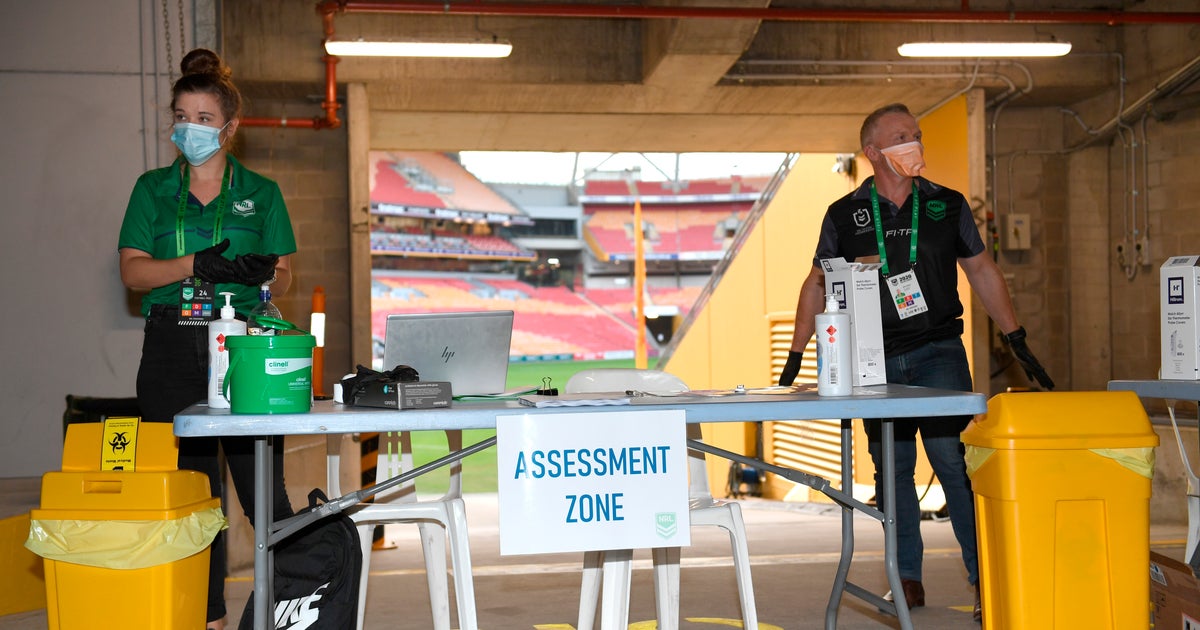NRL’s return has some questionable fever checks


BRISBANE, Australia (AP) — The biggest obstacle facing some National Rugby League players in their return to play following a coronavirus shutdown isn’t how they perform on the field, but whether they can pass an often inconsistent ear-temperature check on game day.
And players’ earphones and headsets may be part of the problem
When the NRL returned without fans last weekend, league officials said players would have to undergo up to three temperature checks on the day of a game.
Last Thursday, Australia fullback James Tedesco became the first player to miss a game under the NRL’s new health protocols in the coronavirus pandemic because he woke up with a high temperature.
Tedesco failed a test that prohibits anyone with a temperature above 37.2 Celsius (98.96 Fahrenheit) from entering a stadium on game day or for practice. He was ruled out of the Sydney Roosters’ lineup, but he wasn’t really missed in his side’s 59-0 win over the Broncos in Brisbane.
Brisbane halfback Brodie Croft had two high readings before the first NRL comeback match last Thursday against Parramatta, but he eventually passed another temperature check and was allowed to play.
It was more of the same last weekend. Six Cronulla players arrived at the ground on Saturday night and gave temperature readings over the 37. 2 cutoff.
All six were eventually allowed into the stadium at Townsville in north Queensland state after a second examination 15 minutes after their initial test, with suggestions a different machine was used for the second test.
Three Sydney Roosters players __ Kyle Flanagan, Joey Manu and Brett Morris __ also failed initial temperature tests on Thursday night before passing a later test.
Three players would have to fail pregame temperature checks before the league considered calling a game off, NRL’s head of football Graham Annesley told Australian Associated Press.
“There’s no automatic decision on any of that stuff. There’s a process that kicks in immediately when we have a problem,” Annesley told AAP.
Body temperatures, according to the respected Mayo Clinic in the United States, are not always an exact science.
“Normal body temperature varies throughout the day __ it’s lower in the morning and higher in the late afternoon and evening,” it says on its website “Although most people consider 98.6 F (37 C) normal, your body temperature can vary by a degree or more — from about 97 F (36.1 C) to 99 F (37.2 C) — and still be considered normal.”
And while ear, or tympanic, temperature checks might be the more convenient way to check for fevers, they are not the most accurate.
“Oral and rectal thermometers generally provide the most accurate measurement of core body temperature,” the Mayo Clinic says. “Ear or forehead thermometers, although convenient, provide less accurate temperature measurements.”
NRL teams carry 20 players on game day, giving coaches some flexibility should a player check in over the temperature threshold before the match.
Canterbury coach Dean Pay said his players have been urged to avoid the use of headphones on game-day in a bid to keep their temperatures down.
“The headphones is a real issue that’s raised with us,” Pay said. “Last week when we were on the bus on the way up to Central Coast, we made sure our players took them off well in advance before they got to the ground.”
On the other side of the scale, Australian Broadcasting Corp.’s Grandstand radio sports show on Sunday reported that an unnamed player came down with some sniffles on game day.
Concerned that he might not pass the fever check, but confident he was well enough to play and had no other COVID-19 symptoms, he stuffed a few small ice cubes into his ears on the bus on the way to the stadium.
He passed with flying colors.






